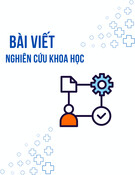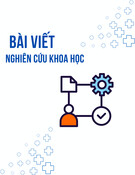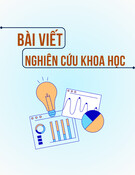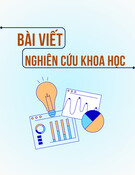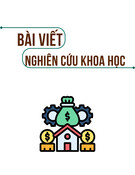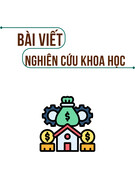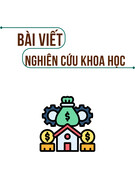CHAPTER 3
PUBLIC POLICY and PUBLIC ANALYSIS
SU DINH THANH
LEARNING OBJECTIVES LEARNING OBJECTIVES
(cid:131) Understanding the definition of public policy (cid:131) Understanding the steps of public analysis
DEFINITION OF PUBLIC POLICY & ANALYSIS
(cid:132) Public policy and policy analysis focus on researching on
what governments do. (cid:132) The public administration concern with how they operate, d i i t bli
ith h
t
Th th ti and in using empirical methods to analyse policy.
rules covering future behaviour
(cid:132) Definitions of public policy found in the literature range (cid:132) Definitions of public policy found in the literature range from ‘declarations of intent, a programme of goals, and general to important government decisions, a selected line or course of action, the consequences of action or inaction, and even all government action’ (Lynn, 1987) 1987) ti
’ (L
t
Definition… Definition
to find that p blic polic
(cid:132) It is easy to find that public policy is to be regarded is to be regarded (cid:132) It is eas here as the output of government and policy analysis is an empirical approach to deri ing and e plaining an empirical approach to deriving and explaining policy.
POLICY ANALYSIS POLICY ANALYSIS
(cid:132) Public policy began with the systematic analysis of data (cid:132) P blic polic began ith the s stematic anal sis of data
for governmental purposes.
(cid:132) Empirical methods were to be used to aid decision-
id d i i
h d
b
d
l
making in public policy.
Empirical methods Empirical methods
(cid:132) Some of the empirical methods used in policy analysis (cid:132) Some of the empirical methods used in policy analysis
include: (cid:132) (i) benefit–cost analysis (optimum choice among discrete (cid:132) (i) benefit cost analysis (optimum choice among discrete
(cid:132) (ii) decision theory (optimum choice with contingent (cid:132) (ii) decision theory (optimum choice with contingent
alternatives without probabilities);
) p y (cid:132) (iii) optimum level analysis (finding an optimum policy g p p (
probabilities); y ( where doing too much or too little is undesirable); (cid:132) (iv) allocation theory (optimum - mix analysis) and (cid:132) (v) time optimization models (decision - making systems designed to minimize time consumption) (Nagel, 1990).
Empirical methods Empirical methods
(cid:132) Empirical methods undoubtedly would improve the o ld impro e the ndo btedl (cid:132) Empirical methods making of policy. However, there are relatively few m ndane problems mundane problems. (cid:132) Public policy is usually complex and has no easy
answers.
Policy process model Policy process model
(cid:132) Patton and Sawicki (1986) put forward a six-step model (cid:132) Patton and Sa icki (1986) p t for ard a si step model
of policy process : f d f
(cid:132) Step 1: Verify, define and detail the problem
l h
bl
d d (cid:132) Before starting to look at any policy problem, the
first step is, of course, to specify what the problem actually is.
Policy process model Policy process model
(cid:132) Step 2: Establish evaluation criteria (cid:132) St i
2 E t bli h
ti
l
(cid:132) This
it evaluation criteria t
to be
i step allows other t d f id f
could include
t considered instead of always referring to cost. l d i effectiveness, (cid:132) Other valued criteria i political acceptability or even votes and equity. bili d l
from whom the analysis is being carried out for from whom the analysis is being carried out for
li i (cid:132) The criteria may derive from the statement of the problem, or
Policy process model Policy process model
(cid:132) Step 3: Identify alternative policies (cid:132) St
3 Id tif
li i
ti
lt
(cid:132) Once the goals are known and evaluation criteria it should be possible to develop a set of f
ld b ifi d it h ibl d t l t
b id i l
ifi d h through experiments, and
specified, alternative ways of getting to the known goals. (cid:132) Alternatives may also be identified through ‘researched h d h ‘ Al analysis brainstorming techniques, and by writing scenarios techniques and by writing scenarios
Policy process model Policy process model
(cid:132) Step 4: Evaluate alternative policies (cid:132) St
4 E l
li i
lt
ti
t
l l ti th i t l
(cid:132) Once alternative policies are identified, each can be i rigorously evaluated, by deciding the particular points in i t d b d idi favour or against each of the alternative proposals. (cid:132) The evaluation stage should identify those alternatives h Th that are feasible and those that are not; those that will be expensive, or politically impossible. At this point more expensive or politically impossible At this point more data may also have to be collected or the original problem redefined. problem redefined
ld id if h l i l i
Policy process model Policy process model
(cid:132) Step 5: Display and select among alternative policies (cid:132) St t
5 Di
li i
ti
lt
d
l
l
(cid:132) The results of the evaluation may be presented to the client as a list of alternatives, or a preferred alternative. li (cid:132) No alternative is likely to be perfect, instead, all of the
d lt li t lt ti ti f f t
alternatives will have good points and bad points l d b d ill h d i i i
Policy process model Policy process model
(cid:132) Step 6: Monitor policy outcomes (cid:132) St
6 M it
li
t
(cid:132) No policy is complete at this point. There are often in i
difficulties diffi possible ibl lti consequences,
(cid:132) Monitoring or evaluation of progress is, or should be,
i l i ld b h f
unintended i t d d implementation or changes in circumstances. i M i fundamental to any policy
LIMITATIONS OF POLICY ANALYSIS LIMITATIONS OF POLICY ANALYSIS
(cid:132) Quantitative methods (cid:132) Q th d
tit ti
(cid:132) Numbers are useful and provide information to decision- makers but public policy gives them too much emphasis. i It is very easy to decry formal mathematical approaches as being unrealistic if applied to the world of policy and as being unrealistic if applied to the world of policy and politics,
k bli b t h i th li h t
LIMITATIONS … LIMITATIONS …
t
li
di
bli
(cid:132) Separate public policy discipline (cid:132) S
i li (cid:132) Public policy discipline should connect with the di discipline of public administration. If not, public policy was unrealistic.
d i i t i li bli bli If li ti f t
LIMITATIONS … LIMITATIONS …
(cid:132) Over emphasis on decisions (cid:132) O h i
d i i
(cid:132) The absence of personality is a problem for public policy
(cid:132) A faulty model of science
(cid:132) There is reason to believe that public policy analysis is based on a faulty, or at least old-fashioned, model of science
(cid:132) The derivation of empirical methods from those of
d lmodels.
political science was both a strength and a weakness





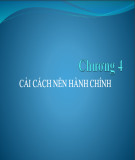
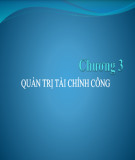
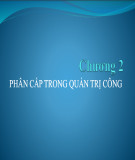





![Đề cương môn học Quản lý nhà nước về đô thị [chuẩn nhất]](https://cdn.tailieu.vn/images/document/thumbnail/2025/20251203/huongle17071999/135x160/84931764744609.jpg)


